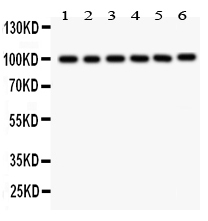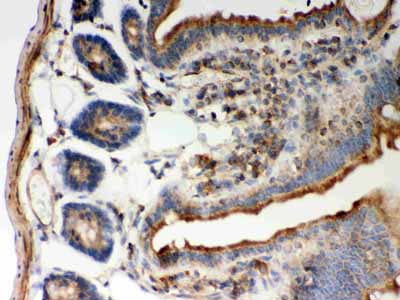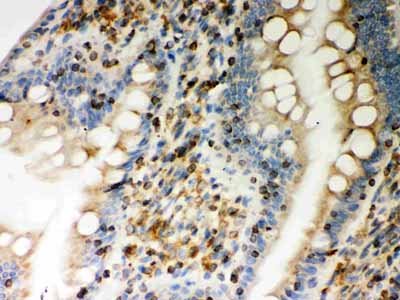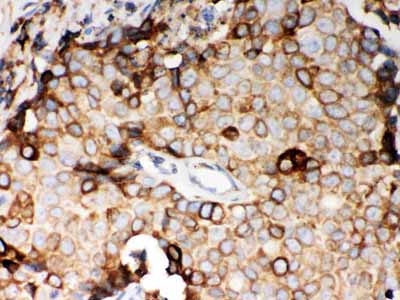Anti-STIM1 Picoband Antibody
- SPECIFICATION
- CITATIONS
- PROTOCOLS
- BACKGROUND

Application
| WB, IHC-P |
|---|---|
| Primary Accession | Q13586 |
| Host | Rabbit |
| Reactivity | Human, Mouse, Rat |
| Clonality | Polyclonal |
| Format | Lyophilized |
| Description | Rabbit IgG polyclonal antibody for Stromal interaction molecule 1(STIM1) detection. Tested with WB, IHC-P in Human;Mouse;Rat. |
| Reconstitution | Add 0.2ml of distilled water will yield a concentration of 500ug/ml. |
| Gene ID | 6786 |
|---|---|
| Other Names | Stromal interaction molecule 1, STIM1, GOK {ECO:0000303|PubMed:9377559} |
| Calculated MW | 77423 MW KDa |
| Application Details | Immunohistochemistry(Paraffin-embedded Section), 0.5-1 µg/ml, Human, Mouse, Rat, By Heat Western blot, 0.1-0.5 µg/ml, Human, Mouse, Rat |
| Subcellular Localization | Cell membrane; Single-pass type I membrane protein. Endoplasmic reticulum membrane; Single-pass type I membrane protein. Cytoplasm, cytoskeleton. Translocates from the endoplasmic reticulum to the cell membrane in response to a depletion of intracellular calcium and is detected at punctae corresponding to junctions between the endoplasmic reticulum and the cell membrane. Associated with the microtubule network at the growing distal tip of microtubules. |
| Tissue Specificity | Ubiquitously expressed in various human primary cells and tumor cell lines. . |
| Protein Name | Stromal interaction molecule 1 |
| Contents | Each vial contains 5mg BSA, 0.9mg NaCl, 0.2mg Na2HPO4, 0.05mg NaN3. |
| Immunogen | A synthetic peptide corresponding to a sequence at the N-terminus of human STIM1(45-74aa AAEFCRIDKPLCHSEDEKLSFEAVRNIHKL), identical to the related mouse and rat sequences. |
| Purification | Immunogen affinity purified. |
| Cross Reactivity | No cross reactivity with other proteins. |
| Storage | At -20˚C for one year. After r˚Constitution, at 4˚C for one month. It˚Can also be aliquotted and stored frozen at -20˚C for a longer time.Avoid repeated freezing and thawing. |
| Sequence Similarities | Contains 1 EF-hand domain. |
| Name | STIM1 |
|---|---|
| Synonyms | GOK {ECO:0000303|PubMed:9377559} |
| Function | Acts as a Ca(2+) sensor that gates two major inward rectifying Ca(2+) channels at the plasma membrane: Ca(2+) release- activated Ca(2+) (CRAC) channels and arachidonate-regulated Ca(2+)- selective (ARC) channels (PubMed:15866891, PubMed:16005298, PubMed:16208375, PubMed:16537481, PubMed:16733527, PubMed:16766533, PubMed:16807233, PubMed:18854159, PubMed:19182790, PubMed:19249086, PubMed:19622606, PubMed:19706554, PubMed:22464749, PubMed:24069340, PubMed:24351972, PubMed:24591628, PubMed:25326555, PubMed:26322679, PubMed:28219928, PubMed:32415068). Plays a role in mediating store- operated Ca(2+) entry (SOCE), a Ca(2+) influx following depletion of intracellular Ca(2+) stores. Upon Ca(2+) depletion, translocates from the endoplasmic reticulum to the plasma membrane where it activates CRAC channel pore-forming subunits ORA1, ORA2 and ORAI3 to generate sustained and oscillatory Ca(2+) entry (PubMed:16208375, PubMed:16537481, PubMed:32415068). Involved in enamel formation (PubMed:24621671). |
| Cellular Location | Cell membrane; Single-pass type I membrane protein. Endoplasmic reticulum membrane; Single-pass type I membrane protein. Cytoplasm, cytoskeleton. Sarcoplasmic reticulum. Note=Translocates from the endoplasmic reticulum to the cell membrane in response to a depletion of intracellular calcium and is detected at punctae corresponding to junctions between the endoplasmic reticulum and the cell membrane (PubMed:16005298, PubMed:16208375, PubMed:18854159, PubMed:19182790, PubMed:19249086). Associated with the microtubule network at the growing distal tip of microtubules (PubMed:19632184). Colocalizes with ORAI1 at the cell membrane (PubMed:27185316). Colocalizes preferentially with CASQ1 at endoplasmic reticulum in response to a depletion of intracellular calcium (PubMed:27185316) |
| Tissue Location | Ubiquitously expressed in various human primary cells and tumor cell lines. |

Thousands of laboratories across the world have published research that depended on the performance of antibodies from Abcepta to advance their research. Check out links to articles that cite our products in major peer-reviewed journals, organized by research category.
info@abcepta.com, and receive a free "I Love Antibodies" mug.
Provided below are standard protocols that you may find useful for product applications.
Background
Stromal interaction molecule 1 is a protein that in humans is encoded by the STIM1 gene. STIM1 has a single transmembranedomain, and is localized to the endoplasmic reticulum, and to a lesser extent to the plasma membrane. This gene encodes a type 1 transmembrane protein that mediates Ca2+ influx after depletion of intracellular Ca2+ stores by gating of store-operated Ca2+ influx channels (SOCs). It is one of several genes located in the imprinted gene domain of 11p15.5, an important tumor-suppressor gene region. Alterations in this region have been associated with the Beckwith-Wiedemann syndrome, Wilms tumor, rhabdomyosarcoma, adrenocrotical carcinoma, and lung, ovarian, and breast cancer. This gene may play a role in malignancies and disease that involve this region, as well as early hematopoiesis, by mediating attachment to stromal cells. Mutations in this gene are associated with fatal classic Kaposi sarcoma, immunodeficiency due to defects in store-operated calcium entry (SOCE) in fibroblasts, ectodermal dysplasia and tubular aggregate myopathy. This gene is oriented in a head-to-tail configuration with the ribonucleotide reductase 1 gene (RRM1), with the 3' end of this gene situated 1.6 kb from the 5' end of the RRM1 gene. Alternative splicing of this gene results in multiple transcript variants.
If you have used an Abcepta product and would like to share how it has performed, please click on the "Submit Review" button and provide the requested information. Our staff will examine and post your review and contact you if needed.
If you have any additional inquiries please email technical services at tech@abcepta.com.













 Foundational characteristics of cancer include proliferation, angiogenesis, migration, evasion of apoptosis, and cellular immortality. Find key markers for these cellular processes and antibodies to detect them.
Foundational characteristics of cancer include proliferation, angiogenesis, migration, evasion of apoptosis, and cellular immortality. Find key markers for these cellular processes and antibodies to detect them. The SUMOplot™ Analysis Program predicts and scores sumoylation sites in your protein. SUMOylation is a post-translational modification involved in various cellular processes, such as nuclear-cytosolic transport, transcriptional regulation, apoptosis, protein stability, response to stress, and progression through the cell cycle.
The SUMOplot™ Analysis Program predicts and scores sumoylation sites in your protein. SUMOylation is a post-translational modification involved in various cellular processes, such as nuclear-cytosolic transport, transcriptional regulation, apoptosis, protein stability, response to stress, and progression through the cell cycle. The Autophagy Receptor Motif Plotter predicts and scores autophagy receptor binding sites in your protein. Identifying proteins connected to this pathway is critical to understanding the role of autophagy in physiological as well as pathological processes such as development, differentiation, neurodegenerative diseases, stress, infection, and cancer.
The Autophagy Receptor Motif Plotter predicts and scores autophagy receptor binding sites in your protein. Identifying proteins connected to this pathway is critical to understanding the role of autophagy in physiological as well as pathological processes such as development, differentiation, neurodegenerative diseases, stress, infection, and cancer.





